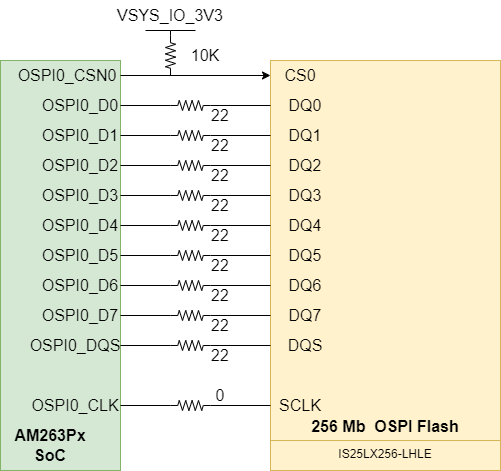SPRUJ85 April 2024
ADVANCE INFORMATION
- 1
- Description
- Key Features
- 1LaunchPad Module Overview
-
2Hardware Description
- 3.1 Board Setup
- 3.2 Functional Block Diagram
- 3.3 GPIO Mapping
- 3.4 Reset
- 3.5 Clock
- 3.6 Memory Interface
- 3.7 Ethernet Interface
- 3.8 I2C
- 3.9 Industrial Application LEDs
- 3.10 SPI
- 3.11 UART
- 3.12 MCAN
- 3.13 FSI
- 3.14 JTAG
- 3.15 TIVA and Test Automation Header
- 3.16 LIN
- 3.17 MMC
- 3.18 ADC and DAC
- 3.19 EQEP and SDFM
- 3.20 EPWM
- 3.21 BoosterPack Headers
- 3.22 Pinmux Mapping
- 3Additional Information
- 4References
- 5Revision History
2.6.1 OSPI
The AM263Px LaunchPad has a 256 Mb OSPI Flash memory device (IS25LX256-LHLE), which is connected to the OSPI0 interface of the AM263Px SoC. The OSPI supports single data rates and double data rates with memory speeds up to 133MHz. The OSPI flash is powered by the 3.3V system supply.
The OSPI0_D0/D1 signals are also used for boot mode control logic. There are 10KΩ resistors used to isolate the boot mode control logic after the value is latched.
 Figure 2-13 OSPI Flash Interface
Figure 2-13 OSPI Flash InterfaceNote:
AM263P_OSPI0_DQS(UART1_RXD) and AM263P_OSPI0_LBCLK(UART1_TXD) net names are swapped in the schematics. Mount R382 with 22E and DNI R381 and R375.